Simon Guerrier's Blog, page 83
October 9, 2013
Doctor Who missing episodes - so what?
 Doctor Who: The Macra Terror, part 4
Doctor Who: The Macra Terror, part 4One of the 106 missing episodesAt last, after months of rumour, the BBC have announced that an as yet undisclosed number of episodes of Doctor Who have been returned to the archive. So what? Why all the excitement? I've been asked this by a few people, so here's my best effort to explain.
Until this new find, there were 106 missing episodes of Doctor Who.
In the 50 years since Doctor Who began, 798 episodes have been broadcast, so just over 13% of all Doctor Who episodes were missing (798/106).
(The next episode, The Day of the Doctor, to be broadcast on 23 November, will be episode 799, the Christmas one after that episode 800).
Episode 798 was also the 102nd new episode since the series came back in 2005 – so there were more episodes missing than those starring Christopher Eccleston, David Tennant and Matt Smith put together.
(Yes, since it came back the episodes have been longer than they were in the 1960s, but still).
The 106 missing episodes were all from the 1960s, all from the first and second Doctors' adventures. There were 253 episodes broadcast in the 1960s; just over 40% of them were missing (253/106).
A third of the first Doctor's episodes (44 of 134) were missing.More than half of the second Doctor's episodes (62 of 119) were missing.
The second Doctor appeared in 21 stories (comprising various numbers of episodes); just six of them were complete – and all but one of those from his last year in the series.
All six episodes of his first story, The Power of the Daleks, were missing, as was the preceding episode - The Tenth Planet part four – in which the Doctor regenerated for the first time.
The last complete story found was the four-episode The Tomb of the Cybermen in 1992; in the 21 years since then, just four more episodes - each from a different story - have been found, plus various brief clips.
Also missing were the first appearance of regular character Brigadier Lethbridge-Stewart, the death of companion Sara Kingdom, the débuts of companions Katarina, Dodo and Jamie, and the departures of companions Vicki, Steven, Polly, Ben and Victoria.
We know an awful lot about the making of Doctor Who – it may be the most painstakingly researched TV show ever. Clips, photographs, scripts and other documents have helped us gain a sense of what missing episodes might have been like. Novelisations, soundtracks and the memories of those who watched or worked on the missing episodes have suggested which ones were particularly good or bad. But nothing compares to seeing the episodes themselves. Of the last two episodes discovered, Galaxy Four: Airlock included a bold speech-to-camera and a flashback scene, while The Underwater Menace part 2 made me entirely reevaluate the story.
We don't yet know how many episodes, or which ones, have been found, or if they include complete stories. That's fuelling speculation and excitement in the run-up to the announcement, which seems due to take place sometime tomorrow afternoon.
So, it's all pretty thrilling. Oh, and here's me on the missing episode least likely to be found.
Published on October 09, 2013 08:49
October 8, 2013
The Quantum Thief by Hannu Rajaniemi
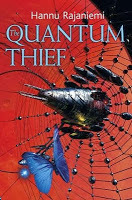 When we first meet space thief Jean le Flambeur he's in prison, forced to play endless versions of the prisoner's dilemma against a fellow prisoner who turns out to be himself. Each time he fails to co-operate, the prison rewrites a bit of his memory and makes him play again, trying to force-evolve him into a more sociable citizen. It's a strange and brilliant idea, and just the start of the story.
When we first meet space thief Jean le Flambeur he's in prison, forced to play endless versions of the prisoner's dilemma against a fellow prisoner who turns out to be himself. Each time he fails to co-operate, the prison rewrites a bit of his memory and makes him play again, trying to force-evolve him into a more sociable citizen. It's a strange and brilliant idea, and just the start of the story.The Quantum Thief (2010) creates an extraordinary future, at the heart of which is the wheeze that, thanks to technological advances, memories live on after bodies die. Bodies die exactly on schedule according to a person's allotted duration (sort of like in Logan's Run ). The 'dead' souls are then transferred to other, less human bodies, to work as slaves for an allotted time, before returning to life. As a result, time is currency; you pay bills in seconds.
Hannu Rajaniemi constructs a rich and complex future. In fact, I sometimes found myself a bit lost. Science fiction often requires us to plunge into an environment we don't understand on the promise that we'll make more sense of it as the story goes on. We pick up clues and learn how things work, which can be very satisfying. But it can also be hard work.
Rajaniemi has a PhD in mathematical physics and this is unabashedly 'hard' sci-fi. There's lots on quantum states and encryption, and at times I couldn't quite keep up with the story. For this poor arts graduate, 'hard' sf might as well mean 'heavy-going', with the same kind of fascination for technology and hardware you get in war fiction, where it's all statistics of weapons and vehicles.
That's a shame because the story is, at heart, a classic heist - Jean using deft tricks and sleights of hand to keep one step ahead of the detective on his trail. But, like the detective, I often found myself baffled by what was going on, only realising later what Jean had managed to achieve. The effect was to distance me from the action; I didn't feel for the characters.
It doesn't help that the book is so humourless. And I'm not sure it quite delivers on its early promise. The plot ultimately hangs on some sci-fi horcruxes, and the last big battle falls rather flatly. In a world where few people ever really die, it's difficult to feel any great fear for people involved. Rajaniemi's future is constructed so robustly I didn't feel enough was at stake.
Published on October 08, 2013 05:01
September 28, 2013
A Delicate Truth by John le Carré
I'd forgotten the delicious thrill of a novel by John le Carré.
There was a time when I glutted on his books - and reported all to this very blog. I read The Secret Pilgrim and The Constant Gardener in August 2005, shortly before seeing the film of The Constant Gardener, I read Tinker, Tailor, Soldier, Spy in April 2006, The Honourable Schoolboy the following month and Smiley's People the month after that, The Mission Song in January 2007 and The Looking-Glass War in December 2008. (I also read - and loved - Call for the Dead at some point in that period, but seem not to have blogged about it; and I'd read le Carré in the far-off days before this blog, too.)
His newest novel, A Delicate Truth is all very familiar: an intelligence job goes wrong and is hushed up, but three of the people involved won't let it go. As they attempt to uncover what happened - and who is to blame - the establishment closes around them...
As always, le Carré creates distinct and real characters, most drawn from the country's best schools, all conjured with names and quirks that seem effortless, as if he's copied them down from real life.
For example, former ambassador Sir Christopher 'Kit' Probyn, is diligent, keen and, moving to a new home, deftly learns his new neighbours' names and habits and history, weaving himself into the community. His wife's illness - sparingly mentioned - adds an extra note of grace to a character we quickly warm to, which makes it all the more effective when he's dismissed by his masters as a 'low-flyer' and used in their wretched scheme.
Le Carré's brilliant at building tension as the story plays out. The plot hinges on the privatisation of intelligence work, and the inevitable blunders - and deaths - that result from applying a payment-by-results approach to such uncertain work. The prose is elegant, full of choice detail and often witty, but this is an angry book, the intelligence sector just one further target of a general policy to open up public service to carpet-baggers and zealots. That policy is sociopathic, as he fumes late on (I've redacted the names so as not to spoil the story):
There was a time when I glutted on his books - and reported all to this very blog. I read The Secret Pilgrim and The Constant Gardener in August 2005, shortly before seeing the film of The Constant Gardener, I read Tinker, Tailor, Soldier, Spy in April 2006, The Honourable Schoolboy the following month and Smiley's People the month after that, The Mission Song in January 2007 and The Looking-Glass War in December 2008. (I also read - and loved - Call for the Dead at some point in that period, but seem not to have blogged about it; and I'd read le Carré in the far-off days before this blog, too.)
His newest novel, A Delicate Truth is all very familiar: an intelligence job goes wrong and is hushed up, but three of the people involved won't let it go. As they attempt to uncover what happened - and who is to blame - the establishment closes around them...
As always, le Carré creates distinct and real characters, most drawn from the country's best schools, all conjured with names and quirks that seem effortless, as if he's copied them down from real life.
For example, former ambassador Sir Christopher 'Kit' Probyn, is diligent, keen and, moving to a new home, deftly learns his new neighbours' names and habits and history, weaving himself into the community. His wife's illness - sparingly mentioned - adds an extra note of grace to a character we quickly warm to, which makes it all the more effective when he's dismissed by his masters as a 'low-flyer' and used in their wretched scheme.
Le Carré's brilliant at building tension as the story plays out. The plot hinges on the privatisation of intelligence work, and the inevitable blunders - and deaths - that result from applying a payment-by-results approach to such uncertain work. The prose is elegant, full of choice detail and often witty, but this is an angry book, the intelligence sector just one further target of a general policy to open up public service to carpet-baggers and zealots. That policy is sociopathic, as he fumes late on (I've redacted the names so as not to spoil the story):
"In a half-hearted effort to find excuses for [character 1], [character 2] even wondered whether, deep down, the man was just plain stupid. How else to explain the cock-up that was [event]? And from there, he wandered off into an argument with Friedrich Schiller's grandiose statement that human stupidity was what the gods fought in vain. Not so, in [character 2]'s opinion, and no excuse for anybody, whether god or man. What the gods and all reasonable humans fought in vain wasn't stupidity at all. It was sheer, wanton, blood indifference to anyone's interests but their own."As always, there are no easy answers or happy endings, and making a stand against the villains means facing appalling consequences. Le Carré conjures a complex, nasty world, one recognisable from the daily news. But the power of the book is in the simplest of concoctions: good people we feel for, struggling against overwhelming odds to do the right thing.
John le Carré, A Delicate Truth (2013), p. 296.
Published on September 28, 2013 07:43
September 27, 2013
"Obamacare in space?" - a review of Elysium
 Standord torus
Standord torusArtwork by Don Davis (1975)I have written a review of Elysium for the Lancet, examining the claim that the film depicts some kind of "Obamacare in space", and comparing it to what must surely be a principal influence: Don Davis' extraordinary paintings of the proposed Stanford torus space station.
(I have previously posted about this on my Tumblr blog, as well.)
Published on September 27, 2013 12:06
September 26, 2013
The Moving Toyshop by Edmund Crispin
Years ago, Gareth Roberts recommended me The Moving Toyshop, written by Edmund Crispin in 1946; I've only just got round to reading it. As Gareth said, it's brilliant: a comic murder-mystery with the feel of The Avengers. I would not be surprised to discover that it was a huge influence on Douglas Adams (especially his Professor Chronotis stories) and Jonathan Creek.
Poet Richard Cadogan finds the dead body of a woman in a toyshop in Oxford, but when he returns with the police the toyshop is not there: instead, the building is a grocer's - and there is no sign of a body. The police assume Richard has made a mistake, so Richard calls his old friend Gervase Fen, Professor of English Language and Literature - and amateur sleuth. What follows is effectively a series of chases, with rich characters playing literary games as they dodge and weave through the arcane twists of the plot. It's a joyous, witty read and the wildest occurrences all turn out to have perfectly logical explanations.
At the end of the book, we learn that "the moving toyshop" is a term from The Rape of the Lock by Pope - a poet referred to earlier in the book in one of the many literary jokes. Rather than investigate the mystery, the police want to discuss Measure for Measure with Fen, who - whenever there's a pause - likes to play games listing unreadable books or bad plays. Crispin pokes fun at Philip Larkin (to whom the book is also dedicated), and even at himself and his chronicling of Fen's adventures.
The light humour neatly plays against moments of darkness and horror: the details of the murders, the shooting of a dog, even the jaded view of Oxford, full of arbitrary rules and abuses. The book's also packed with memorable set pieces: as well as the great gag of the moving toyshop itself, there are scenes in a dodgy old cinema, a college chapel where it's important that men and women use different doors, and a part of the river reserved for nude bathing. Wikipedia even claims - with little hard evidence - that,
Also striking is an archaic use of "slut". One character has:
Poet Richard Cadogan finds the dead body of a woman in a toyshop in Oxford, but when he returns with the police the toyshop is not there: instead, the building is a grocer's - and there is no sign of a body. The police assume Richard has made a mistake, so Richard calls his old friend Gervase Fen, Professor of English Language and Literature - and amateur sleuth. What follows is effectively a series of chases, with rich characters playing literary games as they dodge and weave through the arcane twists of the plot. It's a joyous, witty read and the wildest occurrences all turn out to have perfectly logical explanations.
At the end of the book, we learn that "the moving toyshop" is a term from The Rape of the Lock by Pope - a poet referred to earlier in the book in one of the many literary jokes. Rather than investigate the mystery, the police want to discuss Measure for Measure with Fen, who - whenever there's a pause - likes to play games listing unreadable books or bad plays. Crispin pokes fun at Philip Larkin (to whom the book is also dedicated), and even at himself and his chronicling of Fen's adventures.
The light humour neatly plays against moments of darkness and horror: the details of the murders, the shooting of a dog, even the jaded view of Oxford, full of arbitrary rules and abuses. The book's also packed with memorable set pieces: as well as the great gag of the moving toyshop itself, there are scenes in a dodgy old cinema, a college chapel where it's important that men and women use different doors, and a part of the river reserved for nude bathing. Wikipedia even claims - with little hard evidence - that,
"The book provided the source for the famous merry-go-round sequence at the climax of Alfred Hitchcock's Strangers on a Train. All the major elements of the scene — the two men struggling, the accidentally shot attendant, the out-of-control merry-go-round, the crawling under the moving merry-go-round to disable it — are present in Crispin's account, though Crispin received no screen credit for it."I had some quibbles: one character is dismissed as a suspect solely on the basis that she's a pretty young thing and not overly bright. She's one of only two women to have much of a speaking role in the whole book; another woman appears briefly being chatted up, and two other women are found dead.
"The Moving Toyshop", Wikipedia, retrieved 26 September 2013.
Also striking is an archaic use of "slut". One character has:
"a daily slut who came to cook his meals and make a pretense of cleaning ... The slut, after a day occupied mainly with drinking stout and reading a novelette in the sitting-room, returned to her own house at eight o'clock."But this is a delight of a book, and I'm thrilled to learn Fen has several more adventures...
Edmund Crispin, The Moving Toyshop (1946), p. 186.
Published on September 26, 2013 04:23
September 15, 2013
Doctor Who: 1988
Episode 675: Silver Nemesis, part one
First broadcast: 7.35 pm, Wednesday 23 November 1988
<< back to 1987
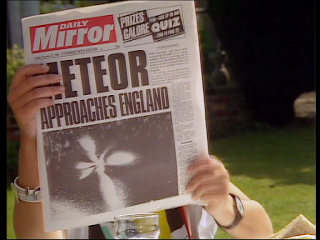 Ace's newspaper
Ace's newspaper
Silver Nemesis, part oneGosh. When, later this year, The Day of the Doctor celebrates 50 years of Doctor Who, part one of Silver Nemesis will be exactly halfway. For this ancient dinosaur who still thinks of the Seventh Doctor as new, that is really quite boggling.
That first episode of Silver Nemesis is also one of just five of the 798 episodes in the series so far that is set on the day it was broadcast:
The Feast of Steven (25 December 1965)
It's Christmas Day in Liverpool at the start of the episode, and there's nothing to suggest it's not 1965.Volcano (1 January 1966)
The TARDIS briefly stops in Trafalgar Square as the bells sound the new year, and again there's nothing to suggest it's not 1966. Logopolis , part one (28 February 1981)
Two stories later, in Four To Doomsday, we learn the date that Tegan missed her flight.Silver Nemesis, part one (23 November 1988)
Ace's newspaper gives the date and it's the day predicted for the return of the comet.The Big Bang (26 June 2010)
The date, given through the series, of Amy's wedding and the TARDIS exploding.
There are a few near misses. Ben says in The Faceless Ones, episode 6, that it's 20 July 1966 - “the day it all started” – but that's four days after the broadcast of The War Machines, episode 4. The Wedding of River Song says the Doctor dies on 22 April 2011, the day before the broadcast of The Impossible Astronaut.
Though the more recent Christmas specials are often set on Christmas Day, they're not set in the year they were first broadcast. The Christmas Invasion, broadcast 25 December 2005, must be set in 2006 because Rose has been away for more than a year according to Aliens of London, where the missing persons poster says she vanished in March 2005. The next Christmas special takes place a year later as it refers to the events of the previous Christmas, so is set in 2007 (but broadcast in 2006), and so on until The End of Time, part one. The last scene of The Doctor, The Widow and the Wardrobe (2011) is set, according to Amy, two years after she last saw the Doctor, on the day of his 'death' in April 2011.
What does any of this matter? Well, for a show that can go anywhere in time, the series rarely lands in the present day. The apparently 'present-day' episodes are often a few years in the future – which, as I've argued before, allows the programme more freedom to destroy famous landmarks, spread deadly plagues and generally create mayhem.
There's also an issue of scheduling: the makers of Doctor Who can't always be certain of the date an episode will be broadcast. It might be bumped for the football or Eurovision, or because of events in the news. The schedules are only confirmed a few weeks ahead of broadcast and anything might change.
I think it's fun that for a series about an erratic time machine that doesn't always go where it's meant to, it never quite lands according to schedule. And that, for a show that's often telling us about the relativistic nature of the 'past' and 'future', events rarely happen 'now'.
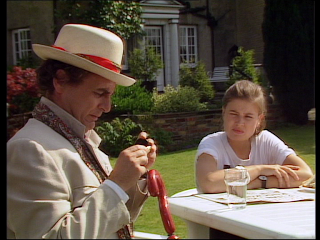 The Doctor can't remember
The Doctor can't remember
where and when he's meant to be,
Silver Nemesis, part one(Thanks to Jonathan Morris and Jim Smith for letting me put some of this to them before posting it.)
Next episode: 1989
First broadcast: 7.35 pm, Wednesday 23 November 1988
<< back to 1987
 Ace's newspaper
Ace's newspaperSilver Nemesis, part oneGosh. When, later this year, The Day of the Doctor celebrates 50 years of Doctor Who, part one of Silver Nemesis will be exactly halfway. For this ancient dinosaur who still thinks of the Seventh Doctor as new, that is really quite boggling.
That first episode of Silver Nemesis is also one of just five of the 798 episodes in the series so far that is set on the day it was broadcast:
The Feast of Steven (25 December 1965)
It's Christmas Day in Liverpool at the start of the episode, and there's nothing to suggest it's not 1965.Volcano (1 January 1966)
The TARDIS briefly stops in Trafalgar Square as the bells sound the new year, and again there's nothing to suggest it's not 1966. Logopolis , part one (28 February 1981)
Two stories later, in Four To Doomsday, we learn the date that Tegan missed her flight.Silver Nemesis, part one (23 November 1988)
Ace's newspaper gives the date and it's the day predicted for the return of the comet.The Big Bang (26 June 2010)
The date, given through the series, of Amy's wedding and the TARDIS exploding.
There are a few near misses. Ben says in The Faceless Ones, episode 6, that it's 20 July 1966 - “the day it all started” – but that's four days after the broadcast of The War Machines, episode 4. The Wedding of River Song says the Doctor dies on 22 April 2011, the day before the broadcast of The Impossible Astronaut.
Though the more recent Christmas specials are often set on Christmas Day, they're not set in the year they were first broadcast. The Christmas Invasion, broadcast 25 December 2005, must be set in 2006 because Rose has been away for more than a year according to Aliens of London, where the missing persons poster says she vanished in March 2005. The next Christmas special takes place a year later as it refers to the events of the previous Christmas, so is set in 2007 (but broadcast in 2006), and so on until The End of Time, part one. The last scene of The Doctor, The Widow and the Wardrobe (2011) is set, according to Amy, two years after she last saw the Doctor, on the day of his 'death' in April 2011.
What does any of this matter? Well, for a show that can go anywhere in time, the series rarely lands in the present day. The apparently 'present-day' episodes are often a few years in the future – which, as I've argued before, allows the programme more freedom to destroy famous landmarks, spread deadly plagues and generally create mayhem.
There's also an issue of scheduling: the makers of Doctor Who can't always be certain of the date an episode will be broadcast. It might be bumped for the football or Eurovision, or because of events in the news. The schedules are only confirmed a few weeks ahead of broadcast and anything might change.
I think it's fun that for a series about an erratic time machine that doesn't always go where it's meant to, it never quite lands according to schedule. And that, for a show that's often telling us about the relativistic nature of the 'past' and 'future', events rarely happen 'now'.
 The Doctor can't remember
The Doctor can't remember where and when he's meant to be,
Silver Nemesis, part one(Thanks to Jonathan Morris and Jim Smith for letting me put some of this to them before posting it.)
Next episode: 1989
Published on September 15, 2013 06:39
September 10, 2013
Doctor Who: 1987
Episode 654: Time and the Rani part 1
First broadcast: 7.35 pm, 7 September 1987
<< back to 1986
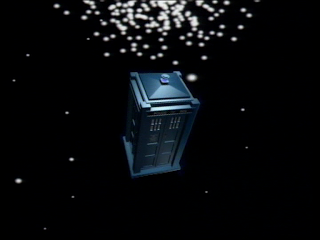 The CGI TARDIS
The CGI TARDIS
Time and the Rani part 1The 1986 season of Doctor Who began with a thrilling special effects sequence: the camera panning across a vast spaceship as it catches the TARDIS in a beam of light. This model shot was some of the first visual effects work on the series by Mike Tucker – who is still working on Doctor Who today. (I hope to speak to Mike on this subject another time.)
The 1987 series of Doctor Who also began with a thrilling special effects sequence as the TARDIS tumbles out of control. But this was not a model shot: it was entirely computer-generated by Oliver Elmes and CAL Video – the same team that created the show's new CGI title sequence. Part 1 of Time and the Rani sees the Seventh Doctor's debut but it's also the first time the TARDIS appears as CGI.
I've been thinking a lot about the role of CGI recently, prompted by a comment made by writer Philip Reeve at the Phonicon convention earlier this year. Explaining how he came up with his extraordinary Mortal Engines , he spoke of trying to achieve “the Clangers aesthetic mixed up with an action movie”, and of how much he admired the “hand-made” feel of old children's telly.
On 20 August – 50 years to the day after the first studio session on Doctor Who had made wobbly bits of light for the title sequence – I asked Philip to expand on what he meant.
What sort of hand-made children's telly were you thinking of?
I grew up in the 70s so I'm thinking back to The Clangers, Noggin the Nog and things like that – quite simple children's television – and also Doctor Who in those days. In fact, if you look back at pretty much all television drama of that era, like Poldark or The Onedin Line, it's not trying to compete with film in the way that TV drama does now. It's theatre: filmed theatre. The scenes outside the windows are painted and it's very obvious that people are not sitting in real rooms but sets. That requires the audience to bring a certain amount of imagination to it, which is something that has gone from television now. It just tries to look real.
Is that the appeal of hand-made TV – that the audience is more active in watching it?
Hmm... Yeah, I think partly so. Of course, with children's stuff particularly there's an element of toys coming to life. Children do that all the time anyway with their toys, moving objects around and animating them in their own minds. So I think there's always an appeal to children of little things moving about as if by magic. They very quickly get across that barrier of thinking “This is made of plasticine but I accept it”. That is entirely good, using the imagination children have anyway.
So does CGI take away from that?
Lots of CGI stuff is great: the CGI animation is very good in something like Monsters Inc or whatever – as good as cell or stop-motion animation. It's just a different look. But I am tired of CGI stuff in science-fiction movies. Avatar, for all it's script problems, was extremely beautiful and the first CGI movie which actually convinced me. I just don't see where you go from there; I don't think there's much point pursuing that sort of pseudo-realism. Watching Pacific Rim made me think that I would much rather watch someone in a big monster suit trample nice models than see it being done in pixels.
Have you seen Moon, directed by Duncan Jones?
Yes, that's one of the few sci-fi movies of recent years that actually stands out – because he uses miniatures, I think. It's got this certain feel... When you look at the movies of my era – I'm thinking of Alien, Bladerunner and things like that – when the spaceships or whatever go by you know there's something there. You know it's a miniature but at least it's a real thing.
There's a tactile quality to it.
Yes, a quality of something actually being real. Of course, nobody watching the film thinks “Oh, that's really a spaceship going by”. You assume that some sort of trickery is employed. I just think that it makes it so much more visually interesting. Things like Peter Jackson's Lord of the Rings movies had a mixture of miniatures and CGI. I'm not entirely sure what they did but that explains why there's a certain grandeur to the cities and so on, a feeling of these being real things in front of you.
You talked about children animating things anyway, so how much did the tactile quality of old TV encourage you to write and draw stories yourself?
(Long pause) I don't know. It's hard to say, really, because you grow up surrounded by that stuff so I don't know how much it came from within and how much it came from inspiration. Certainly, if I rewatch something like The Goodies or Doctor Who I can see exactly why I thought I could go out and make movies on my dad's super-8 camera because they're very doable. There's a kind of feasibility about them. They haven't got casts of thousands or vast effects. I'm not talking about the special effects so much as the ordinary outdoor scenes of people doing stuff. It was all very achievable – or looked so to me at the age of nine or whatever. I was a movie-maker by the time I was 10 or 11 and I'm sure that was completely inspired by watching things on telly and thinking “Oh yeah, I could do that”. I couldn't – but I almost could.
So how much was your recent Doctor Who e-book, The Roots of Evil, written to have a hand-made feel?
I don't know. As a writer you simply describe things and you're never really sure what pictures will emerge in readers' imaginations. It's kind of a collaboration. I put down the raw materials and it's up to the reader to make it up in their mind. I'm not sure how good their special effects budget is. But in my mind, when I was writing it, I treated it as a nostalgia exercise. I tried to make it feel like the kind of story I would have expected to see in 1978. I tried to go for the achievable sets and effects of that era. I imagined it done with three old tree branches and not much else. But I don't know if that comes across and, to be honest, I don't think it matters. It's aimed at the children of today and I imagine they are brought up on far more sophisticated effects so have a far more impressive picture in their minds than I had in mine when I was writing it. (Laughs) That's fine.
Philip Reeve, thank you very much.
Next episode: 1988
First broadcast: 7.35 pm, 7 September 1987
<< back to 1986
 The CGI TARDIS
The CGI TARDISTime and the Rani part 1The 1986 season of Doctor Who began with a thrilling special effects sequence: the camera panning across a vast spaceship as it catches the TARDIS in a beam of light. This model shot was some of the first visual effects work on the series by Mike Tucker – who is still working on Doctor Who today. (I hope to speak to Mike on this subject another time.)
The 1987 series of Doctor Who also began with a thrilling special effects sequence as the TARDIS tumbles out of control. But this was not a model shot: it was entirely computer-generated by Oliver Elmes and CAL Video – the same team that created the show's new CGI title sequence. Part 1 of Time and the Rani sees the Seventh Doctor's debut but it's also the first time the TARDIS appears as CGI.
I've been thinking a lot about the role of CGI recently, prompted by a comment made by writer Philip Reeve at the Phonicon convention earlier this year. Explaining how he came up with his extraordinary Mortal Engines , he spoke of trying to achieve “the Clangers aesthetic mixed up with an action movie”, and of how much he admired the “hand-made” feel of old children's telly.
On 20 August – 50 years to the day after the first studio session on Doctor Who had made wobbly bits of light for the title sequence – I asked Philip to expand on what he meant.
What sort of hand-made children's telly were you thinking of?
I grew up in the 70s so I'm thinking back to The Clangers, Noggin the Nog and things like that – quite simple children's television – and also Doctor Who in those days. In fact, if you look back at pretty much all television drama of that era, like Poldark or The Onedin Line, it's not trying to compete with film in the way that TV drama does now. It's theatre: filmed theatre. The scenes outside the windows are painted and it's very obvious that people are not sitting in real rooms but sets. That requires the audience to bring a certain amount of imagination to it, which is something that has gone from television now. It just tries to look real.
Is that the appeal of hand-made TV – that the audience is more active in watching it?
Hmm... Yeah, I think partly so. Of course, with children's stuff particularly there's an element of toys coming to life. Children do that all the time anyway with their toys, moving objects around and animating them in their own minds. So I think there's always an appeal to children of little things moving about as if by magic. They very quickly get across that barrier of thinking “This is made of plasticine but I accept it”. That is entirely good, using the imagination children have anyway.
So does CGI take away from that?
Lots of CGI stuff is great: the CGI animation is very good in something like Monsters Inc or whatever – as good as cell or stop-motion animation. It's just a different look. But I am tired of CGI stuff in science-fiction movies. Avatar, for all it's script problems, was extremely beautiful and the first CGI movie which actually convinced me. I just don't see where you go from there; I don't think there's much point pursuing that sort of pseudo-realism. Watching Pacific Rim made me think that I would much rather watch someone in a big monster suit trample nice models than see it being done in pixels.
Have you seen Moon, directed by Duncan Jones?
Yes, that's one of the few sci-fi movies of recent years that actually stands out – because he uses miniatures, I think. It's got this certain feel... When you look at the movies of my era – I'm thinking of Alien, Bladerunner and things like that – when the spaceships or whatever go by you know there's something there. You know it's a miniature but at least it's a real thing.
There's a tactile quality to it.
Yes, a quality of something actually being real. Of course, nobody watching the film thinks “Oh, that's really a spaceship going by”. You assume that some sort of trickery is employed. I just think that it makes it so much more visually interesting. Things like Peter Jackson's Lord of the Rings movies had a mixture of miniatures and CGI. I'm not entirely sure what they did but that explains why there's a certain grandeur to the cities and so on, a feeling of these being real things in front of you.
You talked about children animating things anyway, so how much did the tactile quality of old TV encourage you to write and draw stories yourself?
(Long pause) I don't know. It's hard to say, really, because you grow up surrounded by that stuff so I don't know how much it came from within and how much it came from inspiration. Certainly, if I rewatch something like The Goodies or Doctor Who I can see exactly why I thought I could go out and make movies on my dad's super-8 camera because they're very doable. There's a kind of feasibility about them. They haven't got casts of thousands or vast effects. I'm not talking about the special effects so much as the ordinary outdoor scenes of people doing stuff. It was all very achievable – or looked so to me at the age of nine or whatever. I was a movie-maker by the time I was 10 or 11 and I'm sure that was completely inspired by watching things on telly and thinking “Oh yeah, I could do that”. I couldn't – but I almost could.
So how much was your recent Doctor Who e-book, The Roots of Evil, written to have a hand-made feel?
I don't know. As a writer you simply describe things and you're never really sure what pictures will emerge in readers' imaginations. It's kind of a collaboration. I put down the raw materials and it's up to the reader to make it up in their mind. I'm not sure how good their special effects budget is. But in my mind, when I was writing it, I treated it as a nostalgia exercise. I tried to make it feel like the kind of story I would have expected to see in 1978. I tried to go for the achievable sets and effects of that era. I imagined it done with three old tree branches and not much else. But I don't know if that comes across and, to be honest, I don't think it matters. It's aimed at the children of today and I imagine they are brought up on far more sophisticated effects so have a far more impressive picture in their minds than I had in mine when I was writing it. (Laughs) That's fine.
Philip Reeve, thank you very much.
Next episode: 1988
Published on September 10, 2013 01:12
August 25, 2013
Crossing the Line
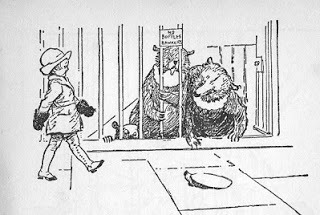 Illustration by EH ShepherdI've written a very short, unsettling story, "Crossing the Line" which you can read free online. It's based on AA Milne's rhyme for children, "Lines and Squares", published in When We Were Very Young (1924).
Illustration by EH ShepherdI've written a very short, unsettling story, "Crossing the Line" which you can read free online. It's based on AA Milne's rhyme for children, "Lines and Squares", published in When We Were Very Young (1924).
Published on August 25, 2013 10:54
August 23, 2013
Victorian dinosaurs
Earlier this week, the Dr pointed me in the direction of Professor Joe Cain's splendid talk on the dinosaur sculptures at Crystal Palace, which you can watch here:
It's a great talk with some amazing insights and pictures - including of the insides of the dinosaurs. I love those dinosaurs and visit them a lot. (They've also appeared twice on the cover of Doctor Who Magazine.)
Then, last night, Nimbos and I attended "Planet of the Dinosaurs", a talk at the Royal Observatory Greenwich, where Dave Hone, paleontologist from Queen Mary gave a history of the dinosaurs as, on the vast Planetarium screen, Earth's continents shifted before our very eyes.
My favourite fact of the evening was about the very well preserved fossils found in Liaoning province in northern China. Paleontologists have not only found the remains of small, feathered dinosaurs, they also know the fauna and weather. In the cool drizzle, dinosaurs would have run through the magnolia blossom and between rhododendrons. Exactly the plants and weather of a Victorian garden - or the Crystal Palace.
 Troodon formosus and Magnolia by John Conway
Troodon formosus and Magnolia by John Conway
It's a great talk with some amazing insights and pictures - including of the insides of the dinosaurs. I love those dinosaurs and visit them a lot. (They've also appeared twice on the cover of Doctor Who Magazine.)
Then, last night, Nimbos and I attended "Planet of the Dinosaurs", a talk at the Royal Observatory Greenwich, where Dave Hone, paleontologist from Queen Mary gave a history of the dinosaurs as, on the vast Planetarium screen, Earth's continents shifted before our very eyes.
My favourite fact of the evening was about the very well preserved fossils found in Liaoning province in northern China. Paleontologists have not only found the remains of small, feathered dinosaurs, they also know the fauna and weather. In the cool drizzle, dinosaurs would have run through the magnolia blossom and between rhododendrons. Exactly the plants and weather of a Victorian garden - or the Crystal Palace.
 Troodon formosus and Magnolia by John Conway
Troodon formosus and Magnolia by John Conway
Published on August 23, 2013 02:03
August 17, 2013
Steven, Leela and Mel
Out in shops now is Doctor Who Magazine's 50th anniversary special - "The Companions".

There's plenty of excitement inside, including three interviews by me. I ask Peter Purves if he's an apologist for William Hartnell, Louise Jameson if Leela was meant to be black and Bonnie Langford if making Doctor Who was more demanding or pressured than other TV shows. ("It was just weirder!" she said.)

There's plenty of excitement inside, including three interviews by me. I ask Peter Purves if he's an apologist for William Hartnell, Louise Jameson if Leela was meant to be black and Bonnie Langford if making Doctor Who was more demanding or pressured than other TV shows. ("It was just weirder!" she said.)
Published on August 17, 2013 05:23
Simon Guerrier's Blog
- Simon Guerrier's profile
- 60 followers
Simon Guerrier isn't a Goodreads Author
(yet),
but they
do have a blog,
so here are some recent posts imported from
their feed.



